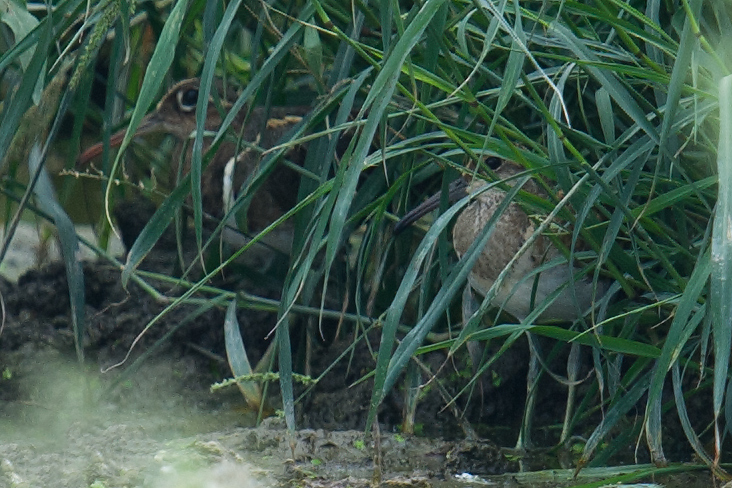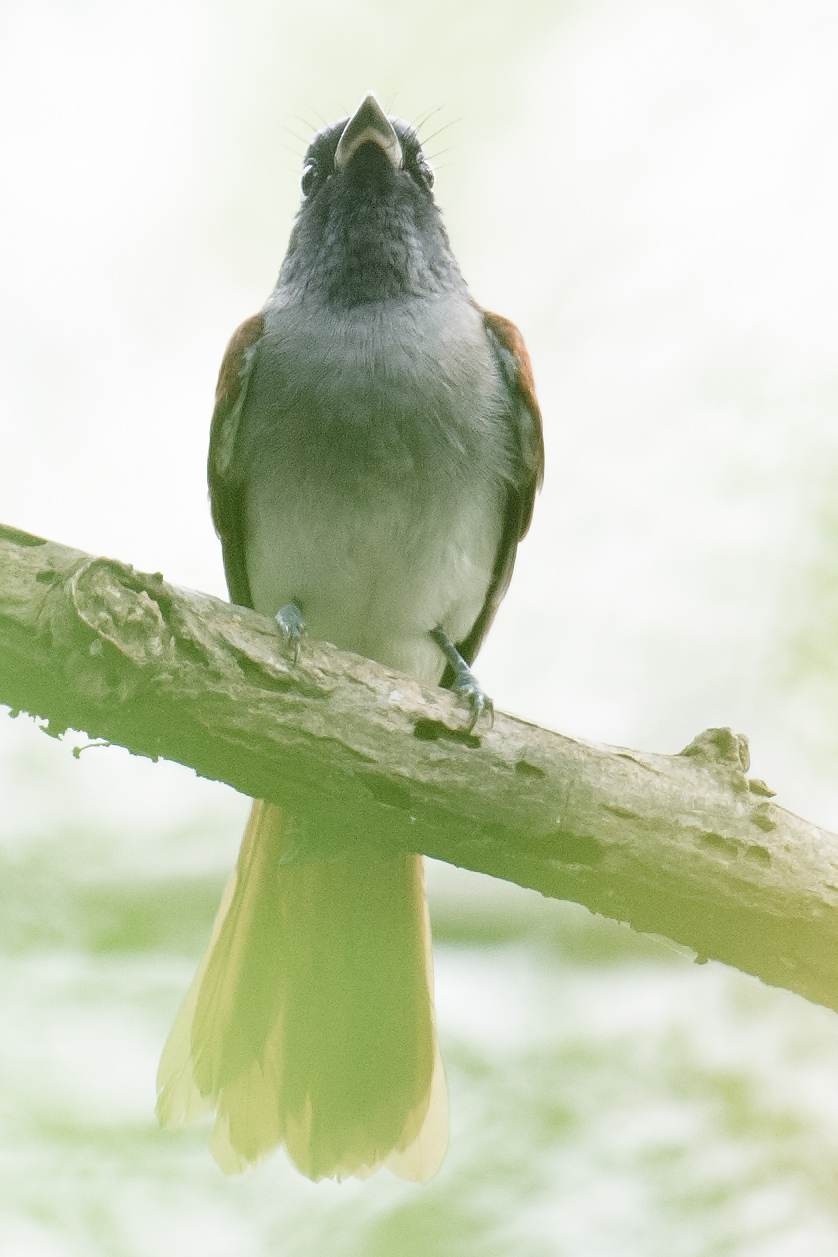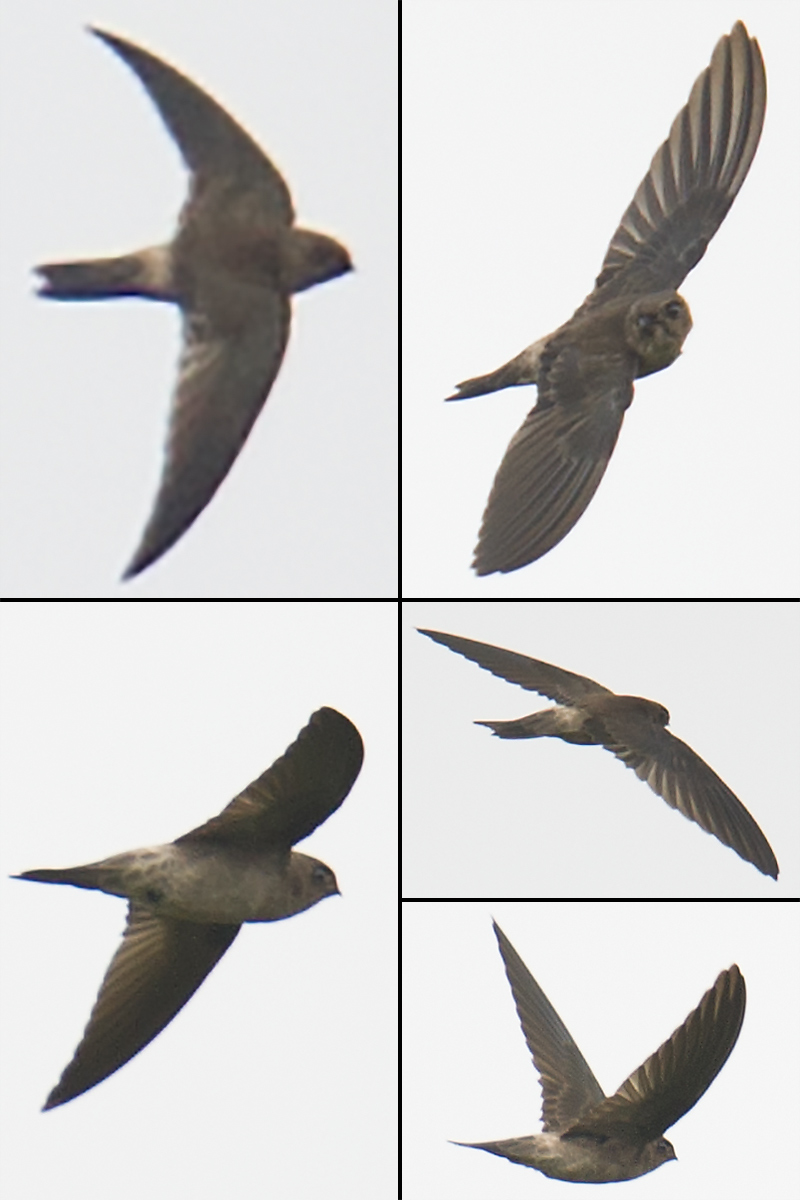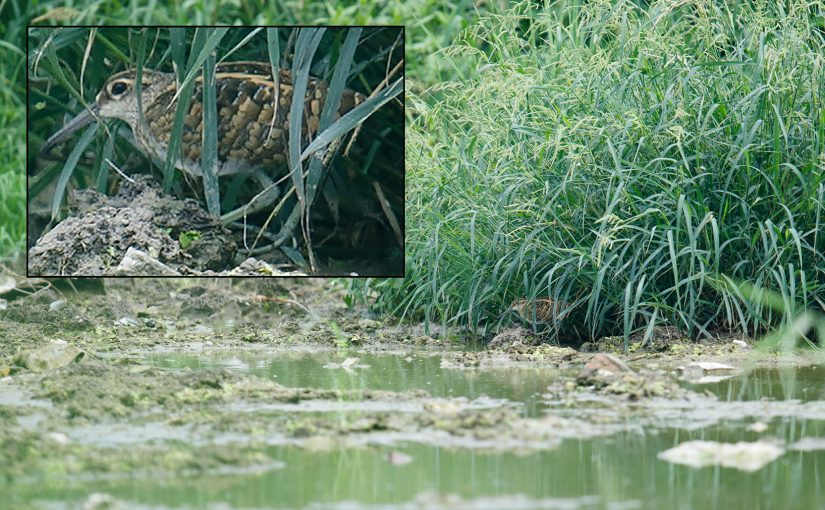by Craig Brelsford
Founder, shanghaibirding.com
I birded 10–14 Aug. with visiting U.S. birder Bob Orenstein. We noted 107 species at coastal sites in Shanghai and southeast Jiangsu. At Pudong’s Cape Nanhui on 13 Aug., Bob and I had a rare Shanghai record of Greater Painted-snipe (above) and an early record of Mandarin Duck. On 12 Aug. at Dongling (32.224520, 121.534355), an impressive site that I had never birded, we had critically endangered Spoon-billed Sandpiper and 2605 endangered Great Knot. We saw 4 Nordmann’s Greenshank at Dongling and had 30 members of that endangered species 11 Aug. at the coastal birding area (32.757056, 120.952294) at Dongtai-Tiaozini. We noted Himalayan Swiftlet at Dongling as well as on 10 Aug. at Cape Nanhui, where we also had Amur Paradise Flycatcher.
Dongling is only 185 km (115 mi.) north of People’s Square in Shanghai, closer than the declining old hot spot of Yangkou (“Rudong”) and the coastal areas at Dongtai-Tiaozini. Through a steady rain 12 Aug., Bob and I found high-tide roosts containing seas of Great Knot plus a single lonely Spoon-billed Sandpiper in complete winter plumage.
Seeing so many Great Knot was extremely heartening. In stark contrast, however, was endangered Far Eastern Curlew, of which only 5 were noted. Unlike near-threatened Eurasian Curlew (130), which though not abundant at Dongling numbered in the thousands at coastal Dongtai, Far Eastern Curlew were abundant nowhere.
On 11 Aug. Bob and I birded the reclaimed area of eastern Hengsha Island. The place was a bustle of activity, even at 5:15 in the morning, with 18-wheelers and dump trucks rumbling by. Security was tight. Guards were stationed at every intersection and in roving vans, one of which stopped us. We told them our purpose was birding; they told us to leave.
Before getting kicked out, Bob and I enjoyed one of my best moments ever with near-threatened Reed Parrotbill. A mega-flock of about 50 birds, much larger than the flocks one sees in the smaller, and ever-shrinking, reedy areas at Cape Nanhui, was making a loud noise during a morning feed. The flock contained juveniles and adults and proved that, provided it has habitat in which to flourish, Reed Parrotbill is a common, even dominant, reed-bed specialist.
I sound-recorded the raucous parrotbills:
Reed Parrotbill Calamornis heudei, 31.307498, 121.895095, 11 Aug., by Craig Brelsford (2:39; 30.7 MB)
Let’s look more closely at some of our birds.
Greater Painted-snipe Rostratula benghalensis

With the help of local Chinese birders, Bob and I found a pair of Greater Painted-snipe in a thickly vegetated, trash-strewn canal. The shy birds were aware of our presence and nervous, but they held their ground. That behavior, in combination with a photo another Chinese birder took suggesting that the male is brooding, persuaded us that the pair has a nest. We moved quickly away and did not return.
Nordmann’s Greenshank Tringa guttifer
Footage I got 11 Aug. at Dongtai figures prominently in this video I made comparing Nordmann’s Greenshank to Common Greenshank.
To further hone your Nordmann’s Greenshank ID skills, and to relive the exciting appearance of Nordmann’s Greenshank in Shanghai, see my post, Your Handy-Dandy Nordmann’s Greenshank ID Primer!
Great Knot Calidris tenuirostris was the star of this four-wader movie I made at Dongling.
Pin-tailed/Swinhoe’s Snipe Gallinago stenura/megala
The video below records one of my closest encounters ever with “Swintail” Snipe. I found this individual 14 Aug. at the sod farm (31.103100, 121.829300) south of Pudong International Airport.
The video shows some of the characters distinguishing this species pair from Common Snipe. (The two species themselves are, except in extraordinary circumstances, indistinguishable from one another.)
As the autumn migration season progresses, the sod farm bears checking; in September at the farm, my partners and I had a rare Shanghai record of Common Ringed Plover.
The video of the snipe as well as the other two videos embedded into this post were made with my combination of iPhone 6 plus PhoneSkope adapter plus Swarovski ATX-95. This powerful combination allows the videographer to shoot usable video from a great distance, allowing even a shy snipe to act naturally. (I never got closer than 40 m to the snipe.)
Amur Paradise Flycatcher Terpsiphone incei

It was an exciting moment 10 Aug. when Amur Paradise Flycatcher appeared in Microforest 1 (30.923889, 121.971635). In the photo above, note the indistinct border between the bluish hood and white belly and the two-tone coloration of the hood—darker blue head, lighter blue breast. In Japanese Paradise Flycatcher, the hood tends to be uniformly colored and the border between the hood and white breast more distinct.
With this year’s fall migration season getting into full swing, paradise flycatchers are going to be moving through Shanghai, and you may wish to improve your skills. For more on separating Amur Paradise Flycatcher from Japanese Paradise Flycatcher, see my post “ID Workshop: Paradise Flycatchers.”
Cuculus sp.
Adults and some juveniles are now moving through Shanghai. In a few weeks, nearly all adult Cuculus cuckoos will be gone, and we will be left with the juveniles. Cuckoos do not sing in autumn, and song of course is by far the best way of distinguishing among the Cuculus cuckoos of our region. I therefore almost invariably mark these silent birds “Cuculus sp.”
Let us say I assigned these silent cuckoos to Common Cuckoo Cuculus canorus. Perhaps they were the size of a sparrowhawk (ruling out thrush-sized Lesser Cuckoo C. poliocephalus), and perhaps they even had yellow irides (ruling out dark-eyed Indian Cuckoo C. micropterus and providing yet more evidence against dark-eyed Lesser Cuckoo).
Even if my cuckoos passed these tests, unless they were singing the classic song (virtually unheard this time of year), how could I justify ID-ing them as Common? It is, of course, likely that some of them are Common, but how can one be sure that any given silent Cuculus cuckoo one is seeing is Common?
I refrain from making speculative species assignments. I refrain because we still do not know enough about the migration patterns in Shanghai of Oriental Cuckoo C. optatus and Himalayan Cuckoo C. saturatus.
Like so many of the woodland passerines that pass through Shanghai on migration, Oriental Cuckoo breeds in northeast China. Like those woodland passerines, Oriental Cuckoo also may pass through Shanghai on migration. Oriental, of course, is very similar to Common, the two species having so many overlapping characters that a firm ID of non-photographed, non-singing birds is all but impossible; and Himalayan, which theoretically may be present in or near our region, is even more similar to Oriental (“virtually identical”—Mark Brazil, Birds of East Asia, p. 256).
In Shanghai it may be tempting to assign silent Cuculus cuckoos, particularly yellow-eyed adults, to Common Cuckoo. Before I started doing that, though, I would want to know more about Oriental Cuckoo and Himalayan Cuckoo in Shanghai. Maybe future studies, using captured cuckoos whose DNA has been analyzed, will reveal a surprising pattern of Cuculus migration in Shanghai. Maybe those studies will show that considerable numbers of Cuculus passage migrants are Oriental Cuckoo.
Until that day comes, I usually hold back from ID-ing non-singing Cuculus cuckoos.
For more information on Shanghai-area cuckoos, see my post, “The Cuckoos of Shanghai.”
Himalayan Swiftlet Aerodramus brevirostris

After being nearly unheard of in Shanghai as recently as a few years ago, Himalayan Swiftlet is now more and more regularly recorded in Shanghai in both spring and autumn.

The question arises of whether Himalayan Swiftlet has always been a scarce passage migrant and overlooked or whether its numbers are increasing in our area. It is of course also possible that both its numbers are increasing in our area and local birders’ skills and communication methods are improving.
That communication methods are improving is indisputable. One of the main causes of the improved communication is the WeChat group I founded, Shanghai Birding. The members of that group, who range from the newest of newbies to some of the most expert birders in China, regularly exchange sightings in real-time.
To join Shanghai Birding, friend me on WeChat (WeChat ID: craigbrelsford). Tell me that you wish to join Shanghai Birding. I’ll add you.
Here is the complete list of the birds noted by Bob Orenstein and me 10-14 Aug.:
Ruddy Shelduck Tadorna ferruginea
Mandarin Duck Aix galericulata
Eastern Spot-billed Duck Anas zonorhyncha
Common Pheasant Phasianus colchicus
Little Grebe Tachybaptus ruficollis
Great Crested Grebe Podiceps cristatus
Great Cormorant Phalacrocorax carbo
Yellow Bittern Ixobrychus sinensis
Cinnamon Bittern I. cinnamomeus
Grey Heron Ardea cinerea
Purple Heron A. purpurea
Great Egret A. alba
Intermediate Egret A. intermedia
Little Egret Egretta garzetta
Eastern Cattle Egret Bubulcus coromandus
Chinese Pond Heron Ardeola bacchus
Striated Heron Butorides striata
Black-crowned Night Heron Nycticorax nycticorax
Eastern Marsh Harrier Circus spilonotus
White-breasted Waterhen Amaurornis phoenicurus
Common Moorhen Gallinula chloropus
Eurasian Coot Fulica atra
Black-winged Stilt Himantopus himantopus
Eurasian Oystercatcher Haematopus ostralegus
Grey Plover Pluvialis squatarola
Pacific Golden Plover P. fulva
Grey-headed Lapwing Vanellus cinereus
Siberian Sand Plover Charadrius mongolus
Greater Sand Plover C. leschenaultii
Kentish Plover C. alexandrinus
Little Ringed Plover C. dubius
Greater Painted-snipe Rostratula benghalensis
Eurasian Whimbrel Numenius phaeopus
Far Eastern Curlew N. madagascariensis
Eurasian Curlew N. arquata
Bar-tailed Godwit Limosa lapponica
Black-tailed Godwit L. limosa
Ruddy Turnstone Arenaria interpres
Great Knot Calidris tenuirostris
Red Knot C. canutus
Broad-billed Sandpiper C. falcinellus
Sharp-tailed Sandpiper C. acuminata
Long-toed Stint C. subminuta
Spoon-billed Sandpiper C. pygmea
Red-necked Stint C. ruficollis
Sanderling C. alba
Dunlin C. alpina
Pin-tailed/Swinhoe’s Snipe Gallinago stenura/megala
Terek Sandpiper Xenus cinereus
Red-necked Phalarope Phalaropus lobatus
Common Sandpiper Actitis hypoleucos
Grey-tailed Tattler Tringa brevipes
Spotted Redshank T. erythropus
Common Greenshank T. nebularia
Nordmann’s Greenshank T. guttifer
Marsh Sandpiper T. stagnatilis
Wood Sandpiper T. glareola
Common Redshank T. totanus
Saunders’s Gull Chroicocephalus saundersi
Black-headed Gull C. ridibundus
Black-tailed Gull Larus crassirostris
Little Tern Sternula albifrons
Gull-billed Tern Gelochelidon nilotica
Caspian Tern Hydroprogne caspia
White-winged Tern Chlidonias leucopterus
Whiskered Tern C. hybrida
Common Tern Sterna hirundo
Feral Pigeon (Rock Dove) Columba livia
Red Collared Dove Streptopelia tranquebarica
Spotted Dove S. chinensis
Lesser Coucal Centropus bengalensis
Cuculus sp.
Himalayan Swiftlet Aerodramus brevirostris
Eurasian Hoopoe Upupa epops
Common Kingfisher Alcedo atthis
Common Kestrel Falco tinnunculus
Peregrine Falcon F. peregrinus
Brown Shrike Lanius cristatus
Long-tailed Shrike L. schach
Amur Paradise Flycatcher Terpsiphone incei
Oriental Magpie Pica serica
Oriental Skylark Alauda gulgula
Pale Martin Riparia diluta
Barn Swallow Hirundo rustica
Red-rumped Swallow Cecropis daurica
Asian House Martin Delichon dasypus
Japanese Tit Parus minor
Light-vented Bulbul Pycnonotus sinensis
Arctic/Kamchatka Leaf Warbler Phylloscopus borealis/examinandus
Eastern Crowned Warbler P. coronatus
Oriental Reed Warbler Acrocephalus orientalis
Zitting Cisticola Cisticola juncidis
Plain Prinia Prinia inornata
Reed Parrotbill Calamornis heudei
Vinous-throated Parrotbill Sinosuthora webbiana
Red-billed Starling Spodiopsar sericeus
White-cheeked Starling S. cineraceus
Crested Myna Acridotheres cristatellus
Chinese Blackbird Turdus mandarinus
Asian Brown Flycatcher Muscicapa dauurica
Oriental Magpie-Robin Copsychus saularis
Yellow-rumped Flycatcher Ficedula zanthopygia
Blue Rock Thrush Monticola solitarius
Eurasian Tree Sparrow Passer montanus
Scaly-breasted Munia Lonchura punctulata
White Wagtail Motacilla alba
Chinese Grosbeak Eophona migratoria

